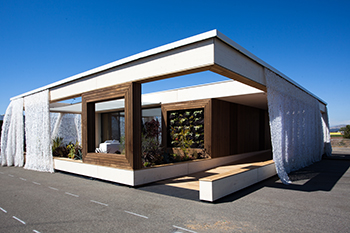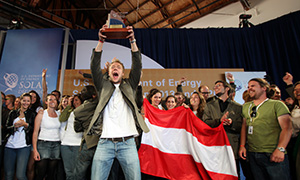 IRVINE, Calif. — The US Department of Energy’s Solar Decathlon 2013 ended Oct. 13 with more than 4,000 college students from 19 teams representing four countries participating in the two-year project.
IRVINE, Calif. — The US Department of Energy’s Solar Decathlon 2013 ended Oct. 13 with more than 4,000 college students from 19 teams representing four countries participating in the two-year project.
The biennial program challenges collegiate teams to design, build and operate solar-powered houses. Competitors are judged upon the designs affordability, attractiveness, environmental conditions and energy consumption.
“The Solar Decathlon is inspiring and training the next generation of clean-energy architects, engineers and entrepreneurs, and showing that affordable clean-energy technologies can help homeowners save money and energy today,” said Ernest Moniz, secretary of the U.S Department of Energy, in a statement.
The first Solar Decathlon was held in 2002 with the aim to educate students and the public about the environmental and economic benefits of clean-energy products and design solutions. This year, the competition houses were open to the public at Orange County Great Park in Irvine, Calif. More than 64,000 visitors toured the homes throughout the 10-day viewing period.
For the first time in the competition’s history, all competitors in the 2013 program designed net-zero homes. According to Richard King, director of the Solar Decathlon, the competition allows students to gain invaluable experience in the field in order to lead future projects.
“Over the past two years, these aspiring clean-energy innovators, engineers and entrepreneurs have received unique training that prepares them to lead the future clean-energy workforce,” King said in a statement.
Each team was scored in 10 different categories with each category accounting for 100 points. The categories included: architecture, market appeal, engineering, communications, affordability, comfort zone, hot water, appliances, home entertainment and energy balance.
Taking first place, achieving 951.9 points, at this year’s competition was Team Austria from Vienna University of Technology. The net-zero project, entitled Living Inspired by Sustainable Innovation (LISI), is powered by a rooftop photovoltaic system and adapts to varying climate zones. The home even provides an annual energy surplus, which can be used to power electric bikes or vehicles, according to the project team. The team stressed the importance of innovative technologies to create sustainable designs.
“The Solar Decathlon is an ideal opportunity to demonstrate Austria’s innovative potential in meeting the biggest technological challenges of our time,” said Karin Stieldorf, project leader for Team Austria, in a statement.
 A centralized utility room contains the building’s automated mechanical systems including a photovoltaic’s monitor, ventilation, plumbing and hot water supply. The home also features two high-efficiency, air-water heat pumps that supply cold and hot water for heating and cooling. A heat-recovering shower tray also reduces the demand for hot water by nearly one-third.
A centralized utility room contains the building’s automated mechanical systems including a photovoltaic’s monitor, ventilation, plumbing and hot water supply. The home also features two high-efficiency, air-water heat pumps that supply cold and hot water for heating and cooling. A heat-recovering shower tray also reduces the demand for hot water by nearly one-third.
The team from the University of Nevada took second place, achieving 947.5 points with their weathered wood rain screen vacation home. The project, known as DesertSol, took inspirations from the Mojave Desert and used the climate’s abundant natural light for solar electricity while capturing rain to provide evaporative cooling and irrigation.
Coming in third place, with 945 points, was a team from Czech Technical University in Prague, Czech Republic. Fourth place went to the teams from Stevens Institute of Technology in Hoboken and fifth place was awarded to a group from Stanford University.
The first Solar Decathlon China took place in August and the third Solar Decathlon Europe is set to take place in Versailles, France in June 2014.

